The Cambridge History of Japan, Vol. 3: Medieval Japan
Подождите немного. Документ загружается.

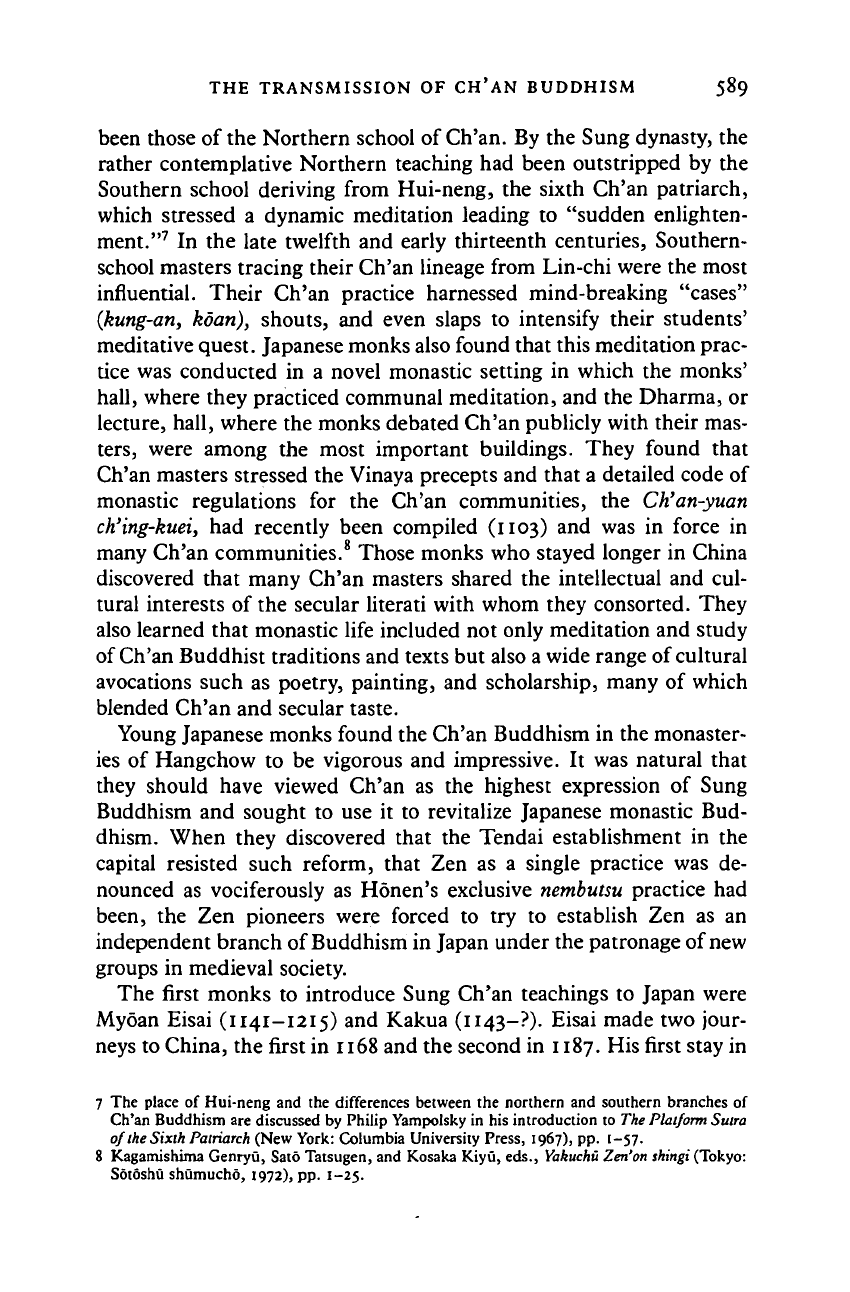
THE TRANSMISSION OF CH'AN BUDDHISM 589
been those of the Northern school of
Ch'an.
By the Sung dynasty, the
rather contemplative Northern teaching had been outstripped by the
Southern school deriving from Hui-neng, the sixth Ch'an patriarch,
' which stressed a dynamic meditation leading to "sudden enlighten-
ment."
7
In the late twelfth and early thirteenth centuries, Southern-
school masters tracing their Ch'an lineage from Lin-chi were the most
influential. Their Ch'an practice harnessed mind-breaking "cases"
(kung-an, koan), shouts, and even slaps to intensify their students'
meditative quest. Japanese monks also found that this meditation prac-
tice was conducted in a novel monastic setting in which the monks'
hall, where they practiced communal meditation, and the Dharma, or
lecture, hall, where the monks debated Ch'an publicly with their mas-
ters,
were among the most important buildings. They found that
Ch'an masters stressed the Vinaya precepts and that a detailed code of
monastic regulations for the Ch'an communities, the Ch'an-yuan
ch'ing-kuei,
had recently been compiled (1103) and was in force in
many Ch'an communities.
8
Those monks who stayed longer in China
discovered that many Ch'an masters shared the intellectual and cul-
tural interests of the secular literati with whom they consorted. They
also learned that monastic life included not only meditation and study
of Ch'an Buddhist traditions and texts but also a wide range of cultural
avocations such as poetry, painting, and scholarship, many of which
blended Ch'an and secular taste.
Young Japanese monks found the Ch'an Buddhism in the monaster-
ies of Hangchow to be vigorous and impressive. It was natural that
they should have viewed Ch'an as the highest expression of Sung
Buddhism and sought to use it to revitalize Japanese monastic Bud-
dhism. When they discovered that the Tendai establishment in the
capital resisted such reform, that Zen as a single practice was de-
nounced as vociferously as Honen's exclusive
nembutsu
practice had
been, the Zen pioneers were forced to try to establish Zen as an
independent branch of Buddhism in Japan under the patronage of new
groups in medieval society.
The first monks to introduce Sung Ch'an teachings to Japan were
Myoan Eisai (1141-1215) and Kakua (1143-?). Eisai made two jour-
neys to China, the first in 1168 and the second in 1187. His first stay in
7 The place of Hui-neng and the differences between the northern and southern branches of
Ch'an Buddhism are discussed by Philip Yampolsky in his introduction to
The
Platform Sutra
of
the
Sixth
Patriarch
(New York: Columbia University Press, 1967), pp. 1-57.
8 Kagamishima Genryu, Sato Tatsugen, and Kosaka Kiyu, eds.,
Yakuchu
Zerion
shingi
(Tokyo:
Sotoshu shumucho, 1972), pp. 1-25.
Cambridge Histories Online © Cambridge University Press, 2008
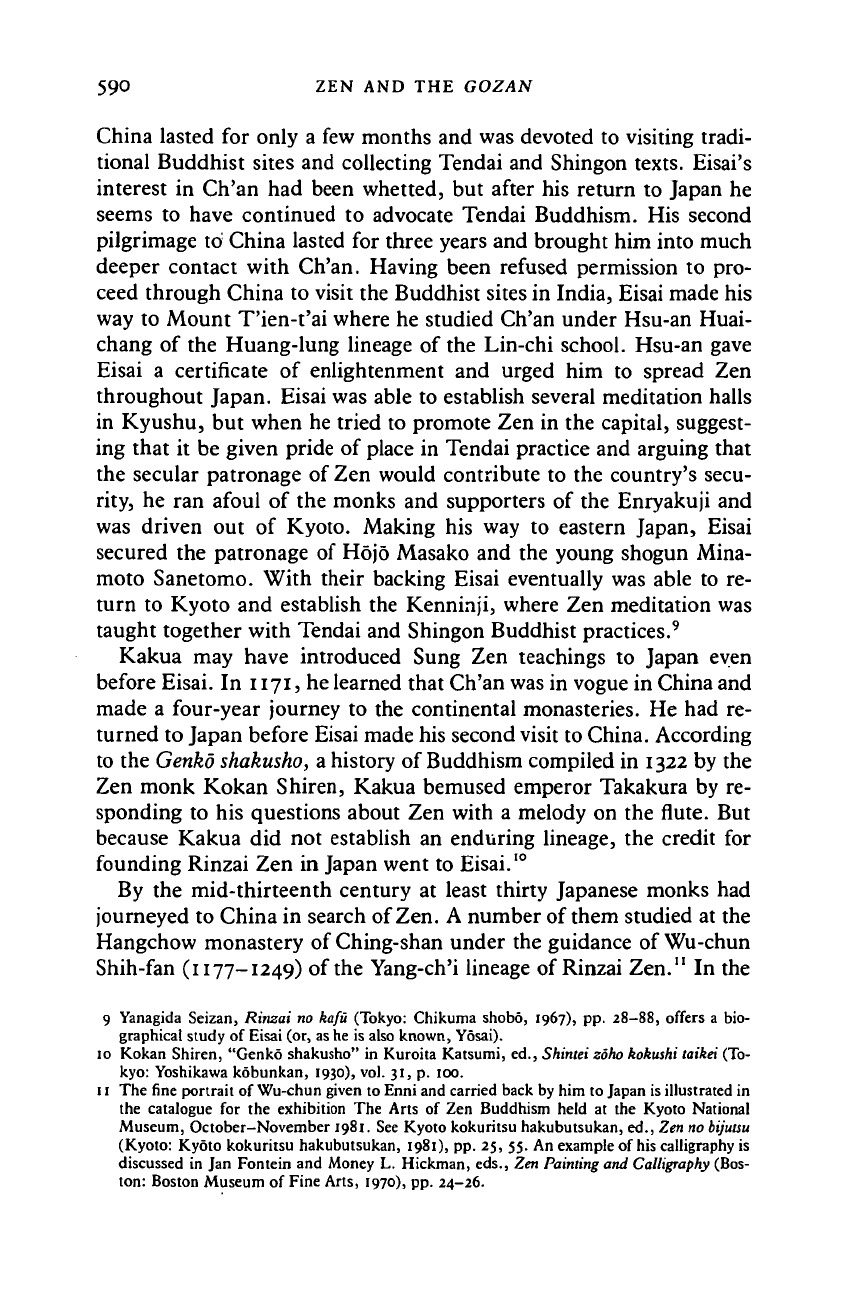
590 ZEN AND THE GOZAN
China lasted for only a few months and was devoted to visiting tradi-
tional Buddhist sites and collecting Tendai and Shingon texts. Eisai's
interest in Ch'an had been whetted, but after his return to Japan he
seems to have continued to advocate Tendai Buddhism. His second
pilgrimage to China lasted for three years and brought him into much
deeper contact with Ch'an. Having been refused permission to pro-
ceed through China to visit the Buddhist sites in India, Eisai made his
way to Mount T'ien-t'ai where he studied Ch'an under Hsu-an Huai-
chang of the Huang-lung lineage of the Lin-chi school. Hsu-an gave
Eisai a certificate of enlightenment and urged him to spread Zen
throughout Japan. Eisai was able to establish several meditation halls
in Kyushu, but when he tried to promote Zen in the capital, suggest-
ing that it be given pride of place in Tendai practice and arguing that
the secular patronage of Zen would contribute to the country's secu-
rity, he ran afoul of the monks and supporters of the Enryakuji and
was driven out of Kyoto. Making his way to eastern Japan, Eisai
secured the patronage of Ho jo Masako and the young shogun Mina-
moto Sanetomo. With their backing Eisai eventually was able to re-
turn to Kyoto and establish the Kenninji, where Zen meditation was
taught together with Tendai and Shingon Buddhist practices.
9
Kakua may have introduced Sung Zen teachings to Japan even
before Eisai. In
1171,
he learned that Ch'an was in vogue in China and
made a four-year journey to the continental monasteries. He had re-
turned to Japan before Eisai made his second visit to China. According
to the
Genko
shakusho,
a history of Buddhism compiled in 1322 by the
Zen monk Kokan Shiren, Kakua bemused emperor Takakura by re-
sponding to his questions about Zen with a melody on the flute. But
because Kakua did not establish an enduring lineage, the credit for
founding Rinzai Zen in Japan went to Eisai.
10
By the mid-thirteenth century at least thirty Japanese monks had
journeyed to China in search of Zen. A number of them studied at the
Hangchow monastery of Ching-shan under the guidance of Wu-chun
Shih-fan (1177-1249) of the Yang-ch'i lineage of Rinzai Zen." In the
9 Yanagida Seizan, Rinzai no kafu (Tokyo: Chikuma shobo, 1967), pp. 28-88, offers a bio-
graphical study of Eisai (or, as he is also known, Yosai).
10 Kokan Shiren, "Genko shakusho" in Kuroita Katsumi, ed., Shimei zoho kokushi laikei (To-
kyo:
Yoshikawa kobunkan, 1930), vol. 31, p. 100.
11 The fine portrait of Wu-chun given to Enni and carried back by him to Japan is illustrated in
the catalogue for the exhibition The Arts of Zen Buddhism held at the Kyoto National
Museum, October-November 1981. See Kyoto kokuritsu hakubutsukan, ed., Zen no
bijutsu
(Kyoto: Kyoto kokuritsu hakubutsukan, 1981), pp. 25, 55. An example of his calligraphy is
discussed in Jan Fontein and Money L. Hickman, eds., Zen Painting and Calligraphy (Bos-
ton: Boston Museum of Fine Arts, 1970), pp. 24-26.
Cambridge Histories Online © Cambridge University Press, 2008
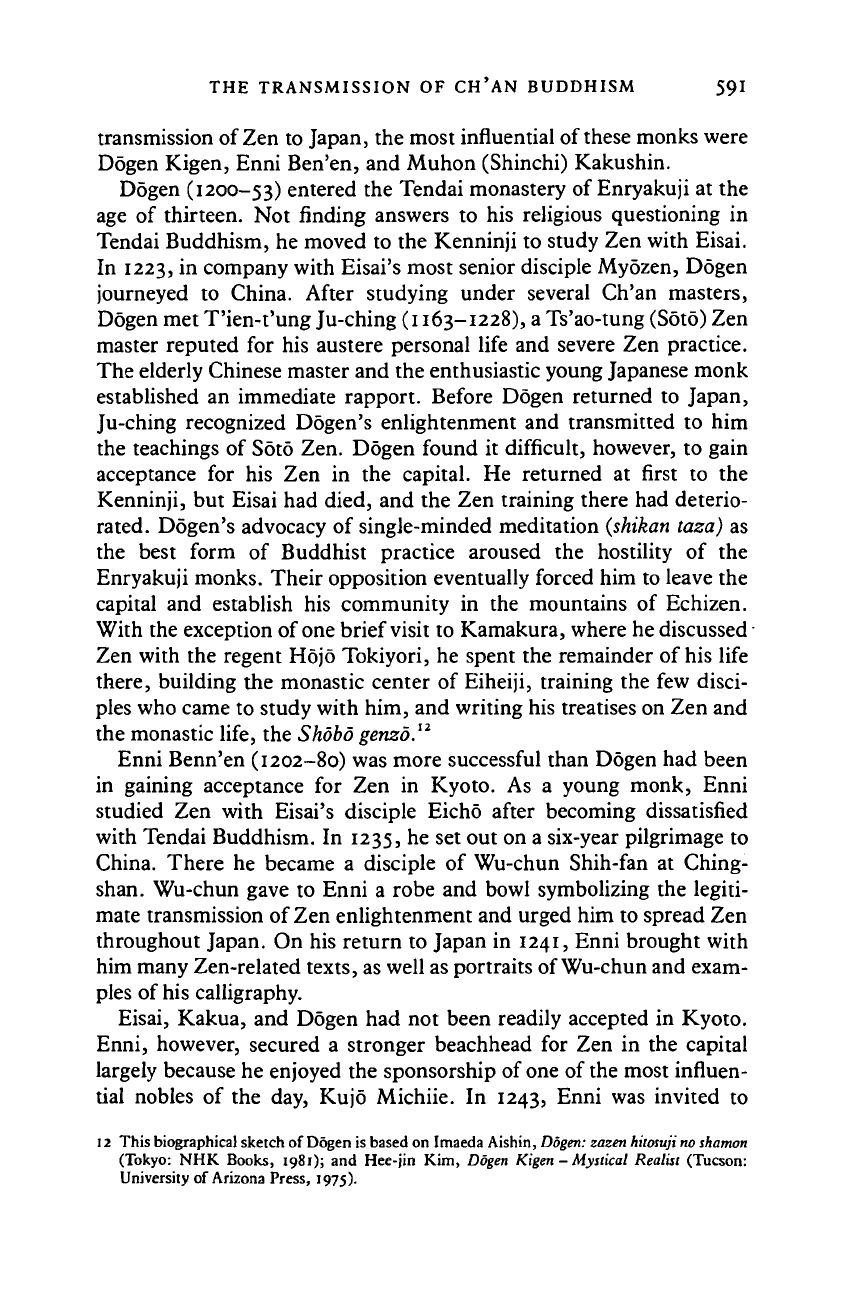
THE TRANSMISSION OF CH'AN BUDDHISM 591
transmission of Zen to Japan, the most influential of
these
monks were
Dogen Kigen, Enni Ben'en, and Muhon (Shinchi) Kakushin.
Dogen (1200-53) entered the Tendai monastery of Enryakuji at the
age of thirteen. Not finding answers to his religious questioning in
Tendai Buddhism, he moved to the Kenninji to study Zen with Eisai.
In 1223, in company with Eisai's most senior disciple Myozen, Dogen
journeyed to China. After studying under several Ch'an masters,
Dogen met T'ien-t'ung Ju-ching (1163-1228),
a
Ts'ao-tung (Soto) Zen
master reputed for his austere personal life and severe Zen practice.
The elderly Chinese master and the enthusiastic young Japanese monk
established an immediate rapport. Before Dogen returned to Japan,
Ju-ching recognized Dogen's enlightenment and transmitted to him
the teachings of Soto Zen. Dogen found it difficult, however, to gain
acceptance for his Zen in the capital. He returned at first to the
Kenninji, but Eisai had died, and the Zen training there had deterio-
rated. Dogen's advocacy of single-minded meditation
(shikan
taza) as
the best form of Buddhist practice aroused the hostility of the
Enryakuji monks. Their opposition eventually forced him to leave the
capital and establish his community in the mountains of Echizen.
With the exception of one brief visit to Kamakura, where he discussed
Zen with the regent Ho jo Tokiyori, he spent the remainder of his life
there, building the monastic center of Eiheiji, training the few disci-
ples who came to study with him, and writing his treatises on Zen and
the monastic life, the
Shobo
genzo.
12
Enni Benn'en (1202-80) was more successful than Dogen had been
in gaining acceptance for Zen in Kyoto. As a young monk, Enni
studied Zen with Eisai's disciple Eicho after becoming dissatisfied
with Tendai Buddhism. In 1235, he set out on a six-year pilgrimage to
China. There he became a disciple of Wu-chun Shih-fan at Ching-
shan. Wu-chun gave to Enni a robe and bowl symbolizing the legiti-
mate transmission of Zen enlightenment and urged him to spread Zen
throughout Japan. On his return to Japan in
1241,
Enni brought with
him many Zen-related texts, as well as portraits of Wu-chun and exam-
ples of his calligraphy.
Eisai, Kakua, and Dogen had not been readily accepted in Kyoto.
Enni, however, secured a stronger beachhead for Zen in the capital
largely because he enjoyed the sponsorship of one of the most influen-
tial nobles of the day, Kujo Michiie. In 1243, Enni was invited to
12 This biographical sketch of Dogen is based on Imaeda Aishin,
Dogen:
zazen
hitosuji
no shamon
(Tokyo: NHK Books, 1981); and Hee-jin Kim, Dogen Kigen - Mystical Realist (Tucson:
University of Arizona Press, 1975).
Cambridge Histories Online © Cambridge University Press, 2008
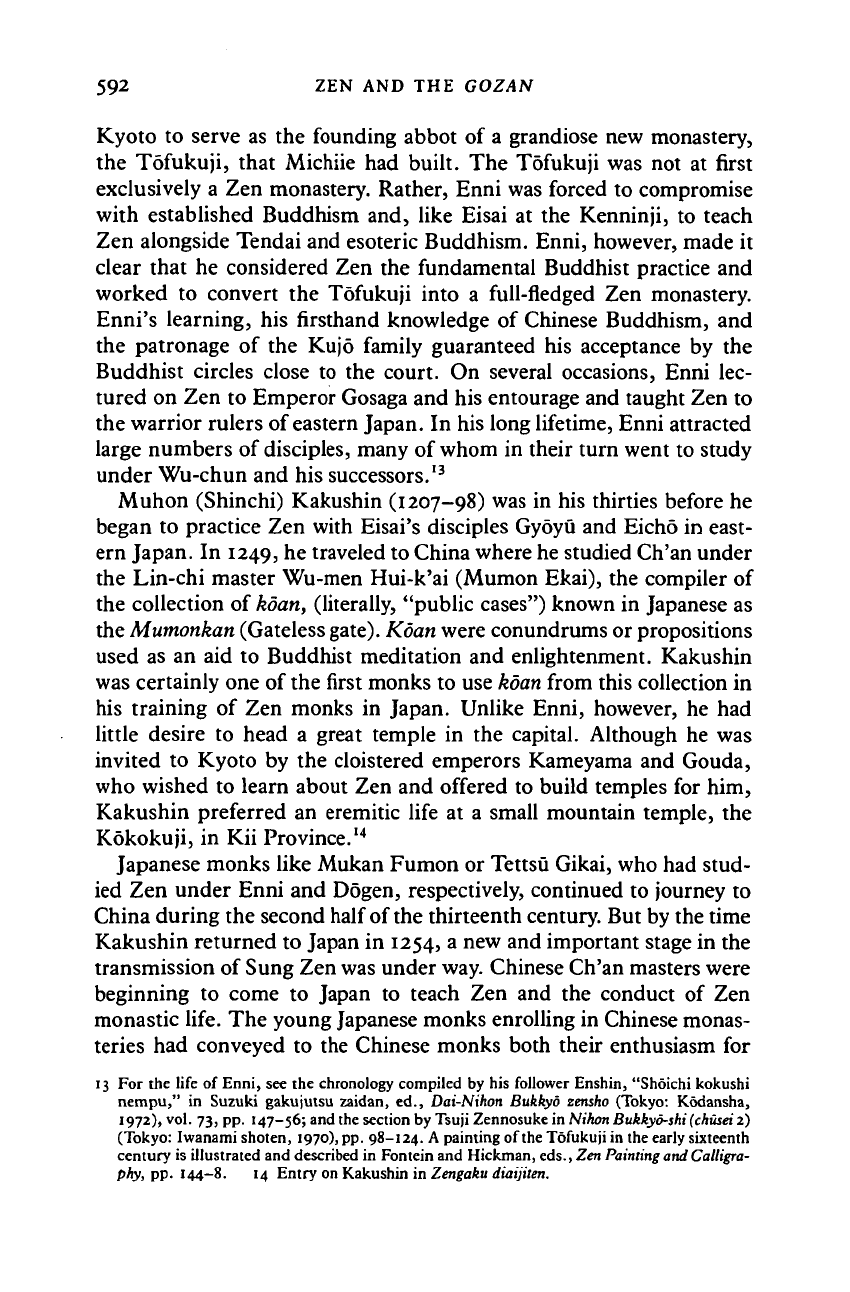
592 ZEN AND THE GOZAN
Kyoto to serve as the founding abbot of a grandiose new monastery,
the Tofukuji, that Michiie had built. The Tofukuji was not at first
exclusively a Zen monastery. Rather, Enni was forced to compromise
with established Buddhism and, like Eisai at the Kenninji, to teach
Zen alongside Tendai and esoteric Buddhism. Enni, however, made it
clear that he considered Zen the fundamental Buddhist practice and
worked to convert the Tofukuji into a full-fledged Zen monastery.
Enni's learning, his firsthand knowledge of Chinese Buddhism, and
the patronage of the Kujo family guaranteed his acceptance by the
Buddhist circles close to the court. On several occasions, Enni lec-
tured on Zen to Emperor Gosaga and his entourage and taught Zen to
the warrior rulers of eastern Japan. In his long lifetime, Enni attracted
large numbers of disciples, many of whom in their turn went to study
under Wu-chun and his successors.
13
Muhon (Shinchi) Kakushin (1207-98) was in his thirties before he
began to practice Zen with Eisai's disciples Gyoyu and Eicho in east-
ern Japan. In 1249, he traveled to China where he studied Ch'an under
the Lin-chi master Wu-men Hui-k'ai (Mumon Ekai), the compiler of
the collection of
koan,
(literally, "public cases") known in Japanese as
the
Mumonkan
(Gateless
gate).
Koan
were conundrums or propositions
used as an aid to Buddhist meditation and enlightenment. Kakushin
was certainly one of the first monks to use
koan
from this collection in
his training of Zen monks in Japan. Unlike Enni, however, he had
little desire to head a great temple in the capital. Although he was
invited to Kyoto by the cloistered emperors Kameyama and Gouda,
who wished to learn about Zen and offered to build temples for him,
Kakushin preferred an eremitic life at a small mountain temple, the
Kokokuji, in Kii Province.
14
Japanese monks like Mukan Fumon or Tettsu Gikai, who had stud-
ied Zen under Enni and Dogen, respectively, continued to journey to
China during the second half of the thirteenth century. But by the time
Kakushin returned to Japan in 1254, a new and important stage in the
transmission of Sung Zen was under
way.
Chinese Ch'an masters were
beginning to come to Japan to teach Zen and the conduct of Zen
monastic life. The young Japanese monks enrolling in Chinese monas-
teries had conveyed to the Chinese monks both their enthusiasm for
13 For the life of Enni, see the chronology compiled by his follower Enshin, "Shoichi kokushi
nempu," in Suzuki gakujutsu zaidan, ed., Dai-Nihon Bukkyo zensho (Tokyo: Kodansha,
1972),
vol. 73, pp. 147-56; and the section by Tsuji Zennosuke in Nihon Bukkyo-thi(chusei2)
(Tokyo: Iwanami shoten, 1970), pp. 98-124. A painting of
the
Tofukuji in the early sixteenth
century is illustrated and described in Fontein and Hickman, eds., Zen
Painting
and Calligra-
phy, pp. 144-8. 14 Entry on Kakushin in Zengaku diaijilen.
Cambridge Histories Online © Cambridge University Press, 2008
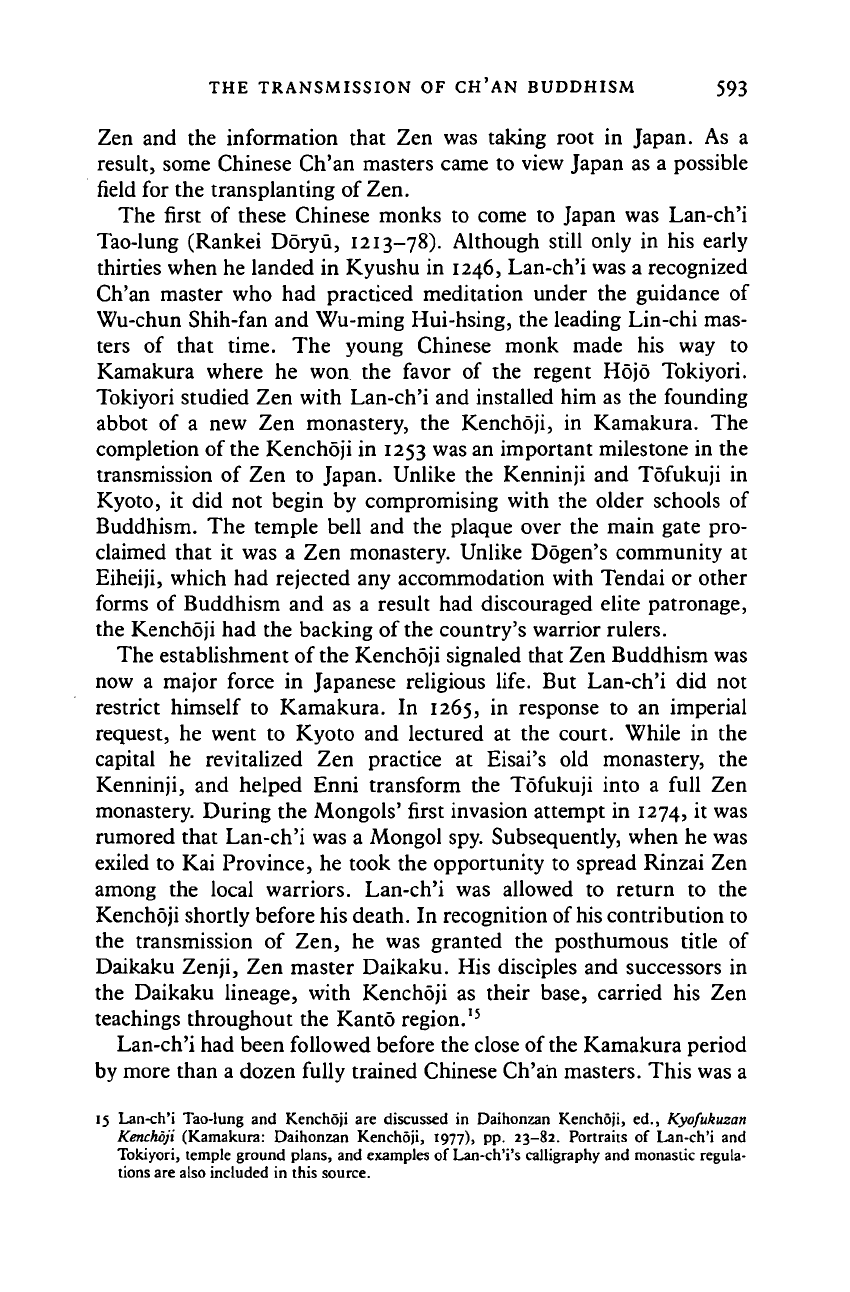
THE TRANSMISSION OF CH'AN BUDDHISM 593
Zen and the information that Zen was taking root in Japan. As a
result, some Chinese Ch'an masters came to view Japan as a possible
field for the transplanting of Zen.
The first of these Chinese monks to come to Japan was Lan-ch'i
Tao-lung (Rankei Doryu, 1213-78). Although still only in his early
thirties when he landed in Kyushu in 1246, Lan-ch'i was a recognized
Ch'an master who had practiced meditation under the guidance of
Wu-chun Shih-fan and Wu-ming Hui-hsing, the leading Lin-chi mas-
ters of that time. The young Chinese monk made his way to
Kamakura where he won the favor of the regent Hojo Tokiyori.
Tokiyori studied Zen with Lan-ch'i and installed him as the founding
abbot of a new Zen monastery, the Kenchoji, in Kamakura. The
completion of the Kenchoji in 1253 was an important milestone in the
transmission of Zen to Japan. Unlike the Kenninji and Tofukuji in
Kyoto, it did not begin by compromising with the older schools of
Buddhism. The temple bell and the plaque over the main gate pro-
claimed that it was a Zen monastery. Unlike Dogen's community at
Eiheiji, which had rejected any accommodation with Tendai or other
forms of Buddhism and as a result had discouraged elite patronage,
the Kenchoji had the backing of the country's warrior rulers.
The establishment of the Kenchoji signaled that Zen Buddhism was
now a major force in Japanese religious life. But Lan-ch'i did not
restrict himself to Kamakura. In 1265, in response to an imperial
request, he went to Kyoto and lectured at the court. While in the
capital he revitalized Zen practice at Eisai's old monastery, the
Kenninji, and helped Enni transform the Tofukuji into a full Zen
monastery. During the Mongols' first invasion attempt in 1274, it was
rumored that Lan-ch'i was a Mongol spy. Subsequently, when he was
exiled to Kai Province, he took the opportunity to spread Rinzai Zen
among the local warriors. Lan-ch'i was allowed to return to the
Kenchoji shortly before his death. In recognition of his contribution to
the transmission of Zen, he was granted the posthumous title of
Daikaku Zenji, Zen master Daikaku. His disciples and successors in
the Daikaku lineage, with Kenchoji as their base, carried his Zen
teachings throughout the Kanto region.
15
Lan-ch'i had been followed before the close of
the
Kamakura period
by more than a dozen fully trained Chinese Ch'an masters. This was a
15 Lan-ch'i Tao-lung and Kenchoji are discussed in Daihonzan Kenchoji, ed., Kyofukuzan
Kenchoji (Kamakura: Daihonzan Kenchoji, 1977), pp. 23-82. Portraits of Lan-ch'i and
Tokiyori, temple ground plans, and examples of Lan-ch'i's calligraphy and monastic regula-
tions are also included in this source.
Cambridge Histories Online © Cambridge University Press, 2008
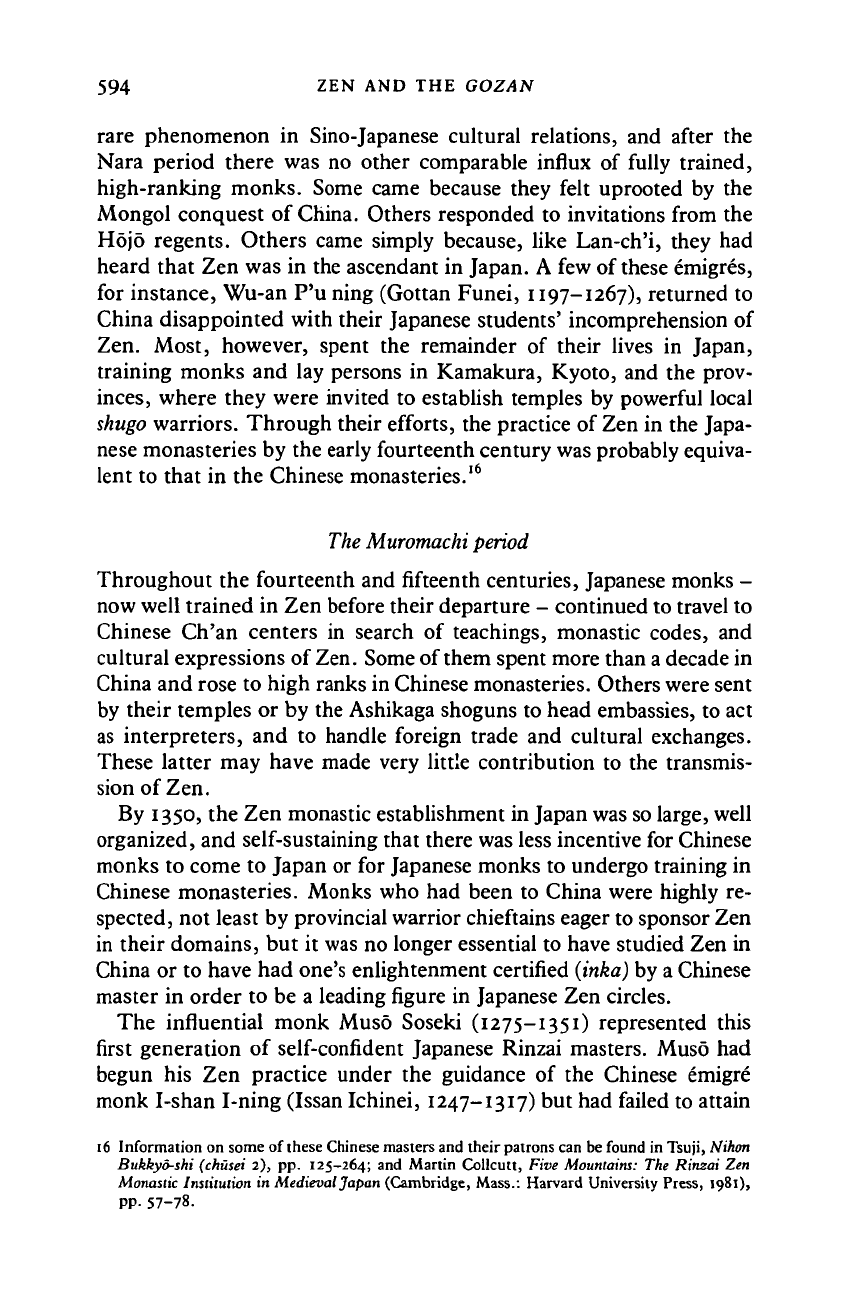
594 ZEN AND THE GOZAN
rare phenomenon in Sino-Japanese cultural relations, and after the
Nara period there was no other comparable influx of fully trained,
high-ranking monks. Some came because they felt uprooted by the
Mongol conquest of China. Others responded to invitations from the
Hojo regents. Others came simply because, like Lan-ch'i, they had
heard that Zen was in the ascendant in Japan. A few of these emigres,
for instance, Wu-an P'u ning (Gottan Funei, 1197-1267), returned to
China disappointed with their Japanese students' incomprehension of
Zen. Most, however, spent the remainder of their lives in Japan,
training monks and lay persons in Kamakura, Kyoto, and the prov-
inces,
where they were invited to establish temples by powerful local
shugo
warriors. Through their efforts, the practice of Zen in the Japa-
nese monasteries by the early fourteenth century was probably equiva-
lent to that in the Chinese monasteries.
16
The Muromachi
period
Throughout the fourteenth and fifteenth centuries, Japanese monks -
now well trained in Zen before their departure - continued to travel to
Chinese Ch'an centers in search of teachings, monastic codes, and
cultural expressions of
Zen.
Some of them spent more than a decade in
China and rose to high ranks in Chinese monasteries. Others were sent
by their temples or by the Ashikaga shoguns to head embassies, to act
as interpreters, and to handle foreign trade and cultural exchanges.
These latter may have made very little contribution to the transmis-
sion of Zen.
By 1350, the Zen monastic establishment in Japan was so large, well
organized, and self-sustaining that there was less incentive for Chinese
monks to come to Japan or for Japanese monks to undergo training in
Chinese monasteries. Monks who had been to China were highly re-
spected, not least by provincial warrior chieftains eager to sponsor Zen
in their domains, but it was no longer essential to have studied Zen in
China or to have had one's enlightenment certified
(inka)
by a Chinese
master in order to be a leading figure in Japanese Zen circles.
The influential monk Muso Soseki (1275-1351) represented this
first generation of self-confident Japanese Rinzai masters. Muso had
begun his Zen practice under the guidance of the Chinese emigre
monk I-shan I-ning (Issan Ichinei, 1247-1317) but had failed to attain
16 Information on some of these Chinese masters and their patrons can be found in Tsuji, Nikon
Bukkyo-shi (chiisei 2), pp. 125-264; and Martin Collcutt, Five Mountains: The Rinzai Zen
Monastic Institution in Medieval Japan (Cambridge, Mass.: Harvard University Press, 1981),
pp.
57-78.
Cambridge Histories Online © Cambridge University Press, 2008
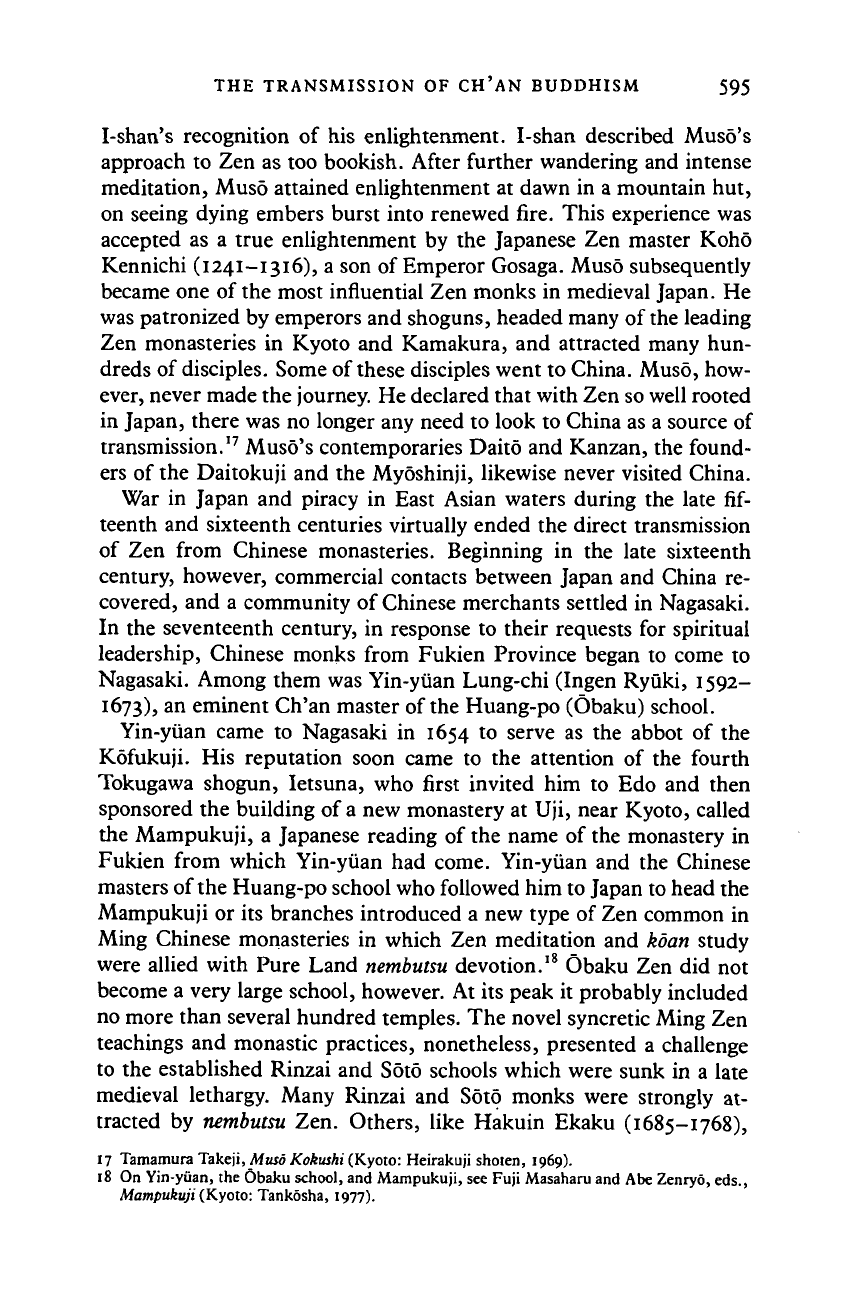
THE TRANSMISSION OF CH'AN BUDDHISM 595
I-shan's recognition of his enlightenment. I-shan described Muso's
approach to Zen as too bookish. After further wandering and intense
meditation, Muso attained enlightenment at dawn in a mountain hut,
on seeing dying embers burst into renewed fire. This experience was
accepted as a true enlightenment by the Japanese Zen master Koho
Kennichi (1241-1316), a son of Emperor Gosaga. Muso subsequently
became one of the most influential Zen monks in medieval Japan. He
was patronized by emperors and shoguns, headed many of the leading
Zen monasteries in Kyoto and Kamakura, and attracted many hun-
dreds of disciples. Some of these disciples went to China. Muso, how-
ever, never made the journey. He declared that with Zen so well rooted
in Japan, there was no longer any need to look to China as a source of
transmission.
17
Muso's contemporaries Daito and Kanzan, the found-
ers of the Daitokuji and the Myoshinji, likewise never visited China.
War in Japan and piracy in East Asian waters during the late fif-
teenth and sixteenth centuries virtually ended the direct transmission
of Zen from Chinese monasteries. Beginning in the late sixteenth
century, however, commercial contacts between Japan and China re-
covered, and a community of Chinese merchants settled in Nagasaki.
In the seventeenth century, in response to their requests for spiritual
leadership, Chinese monks from Fukien Province began to come to
Nagasaki. Among them was Yin-yuan Lung-chi (Ingen Ryuki, 1592-
1673),
an
eminent Ch'an master of the Huang-po (Obaku) school.
Yin-yuan came to Nagasaki in 1654 to serve as the abbot of the
Kofukuji. His reputation soon came to the attention of the fourth
Tokugawa shogun, Ietsuna, who first invited him to Edo and then
sponsored the building of a new monastery at Uji, near Kyoto, called
the Mampukuji, a Japanese reading of the name of the monastery in
Fukien from which Yin-yuan had come. Yin-yuan and the Chinese
masters of the Huang-po school who followed him to Japan to head the
Mampukuji or its branches introduced a new type of Zen common in
Ming Chinese monasteries in which Zen meditation and koan study
were allied with Pure Land
nembutsu
devotion.
18
Obaku Zen did not
become a very large school, however. At its peak it probably included
no more than several hundred temples. The novel syncretic Ming Zen
teachings and monastic practices, nonetheless, presented a challenge
to the established Rinzai and Soto schools which were sunk in a late
medieval lethargy. Many Rinzai and Soto monks were strongly at-
tracted by
nembutsu
Zen. Others, like Hakuin Ekaku (1685-1768),
17 Tamamura Takeji, Muso Kokushi (Kyoto: Heirakuji shoten, 1969).
18 On Yin-yuan, the Obaku school, and Mampukuji, see Fuji Masaharu and Abe Zenryo, eds.,
Mampukuji (Kyoto: Tankosha, 1977).
Cambridge Histories Online © Cambridge University Press, 2008
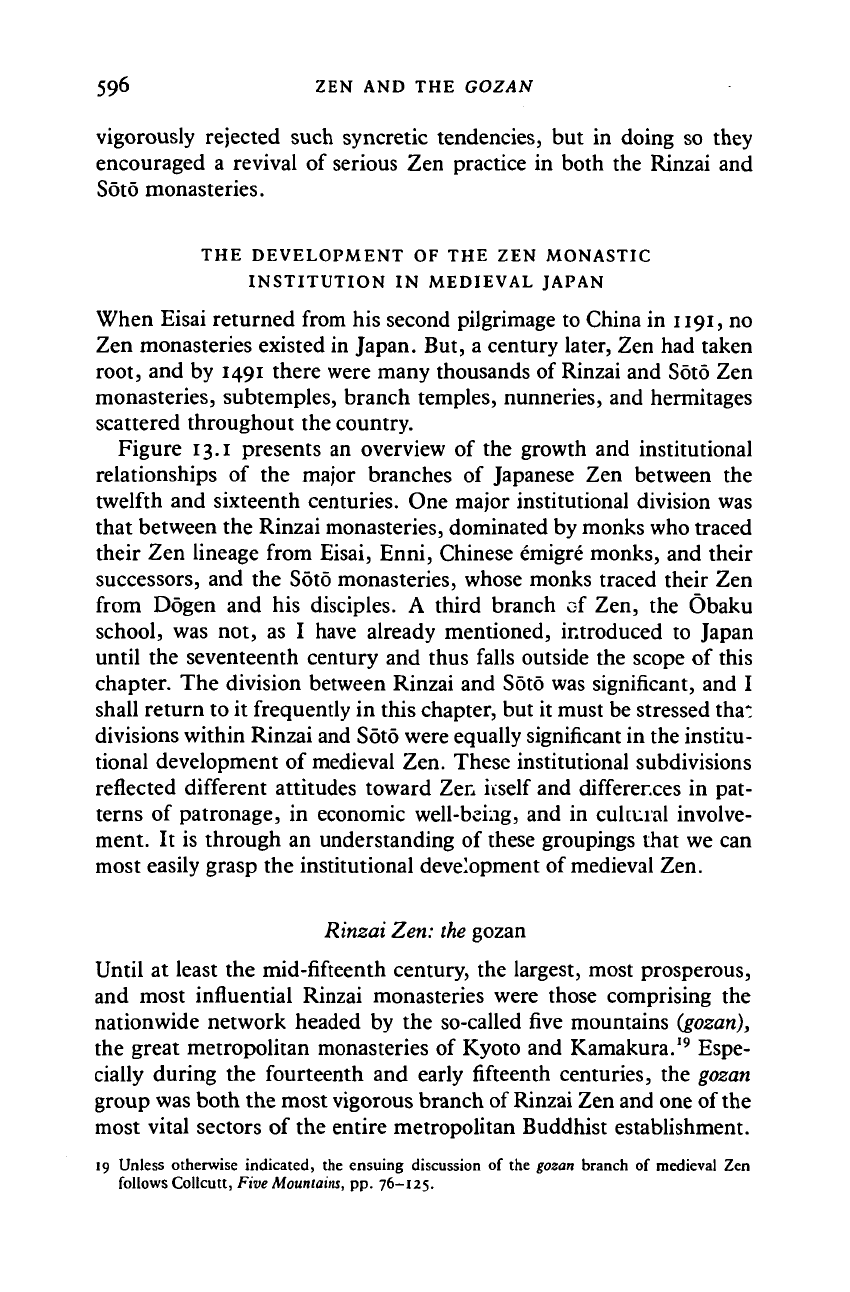
596 ZEN AND THE GOZAN
vigorously rejected such syncretic tendencies, but in doing so they
encouraged a revival of serious Zen practice in both the Rinzai and
Soto monasteries.
THE DEVELOPMENT OF THE ZEN MONASTIC
INSTITUTION IN MEDIEVAL JAPAN
When Eisai returned from his second pilgrimage to China in
1191,
no
Zen monasteries existed in Japan. But, a century later, Zen had taken
root, and by 1491 there were many thousands of Rinzai and Soto Zen
monasteries, subtemples, branch temples, nunneries, and hermitages
scattered throughout the country.
Figure 13.1 presents an overview of the growth and institutional
relationships of the major branches of Japanese Zen between the
twelfth and sixteenth centuries. One major institutional division was
that between the Rinzai monasteries, dominated by monks who traced
their Zen lineage from Eisai, Enni, Chinese emigre monks, and their
successors, and the Soto monasteries, whose monks traced their Zen
from Dogen and his disciples. A third branch of Zen, the Obaku
school, was not, as I have already mentioned, introduced to Japan
until the seventeenth century and thus falls outside the scope of this
chapter. The division between Rinzai and Soto was significant, and I
shall return to it frequently in this chapter, but it must be stressed that
divisions within Rinzai and Soto were equally significant in the institu-
tional development of medieval Zen. These institutional subdivisions
reflected different attitudes toward Zen itself and differences in pat-
terns of patronage, in economic well-being, and in cultural involve-
ment. It is through an understanding of these groupings that we can
most easily grasp the institutional development of medieval Zen.
Rinzai Zen:
the
gozan
Until at least the mid-fifteenth century, the largest, most prosperous,
and most influential Rinzai monasteries were those comprising the
nationwide network headed by the so-called five mountains {gozan),
the great metropolitan monasteries of Kyoto and Kamakura.
19
Espe-
cially during the fourteenth and early fifteenth centuries, the gozan
group was both the most vigorous branch of Rinzai Zen and one of the
most vital sectors of the entire metropolitan Buddhist establishment.
19 Unless otherwise indicated, the ensuing discussion of the gozan branch of medieval Zen
follows Collcutt, Five Mountains, pp. 76-125.
Cambridge Histories Online © Cambridge University Press, 2008
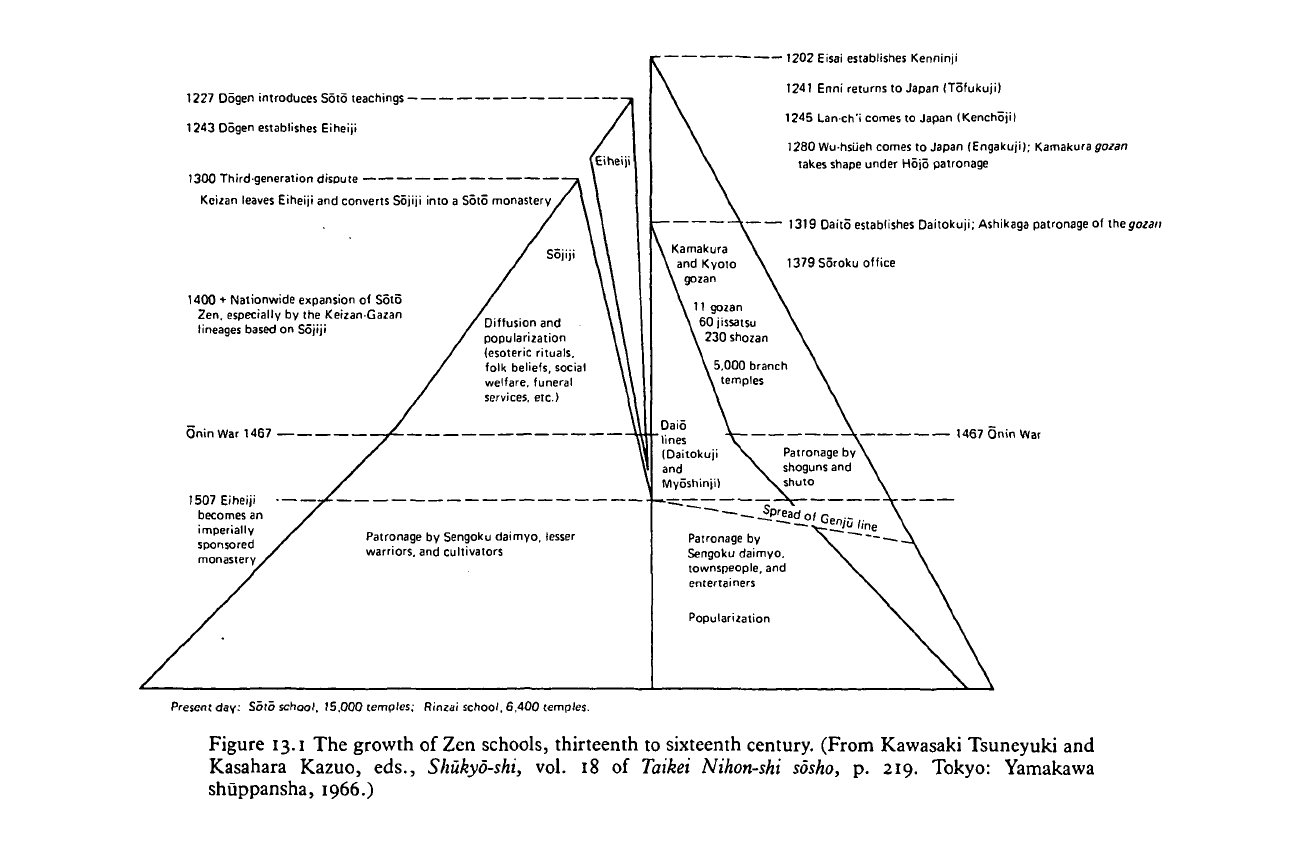
1227 DSgen introduces Soto teachings —
1243 Dogen establishes Eiheiji
1300 Third-generation dispute
Keizan leaves Eiheiji and converts Sojiji into a Soto monastery
1400 + Nationwide expansion of Soto
Zen.
especially by the Keizan-Gazan
lineages based on Sojiji
1202 Eisai establishes Kenninji
1241 Enni returns to Japan (Tofukuji)
1245 Lanch'i comes to Japan (Kenchojil
1280 Wuhsueh comes to Japan (Engakuji); Kamakura gazan
takes shape under Hojo patronage
; \ 1319 Oaito establishes Daitokuji; Ashikaga patronage of the goian
1379 Soroku office
Kamakura
and Kyoto
gozan
11 gozan
60 jissatsu
230 shozan
Diffusion and
popularization
(esoteric rituals,
folk beliefs, social
welfare, funeral
services, etc.)
5,000 branch
temples
Daio
nes
(Daitokuji
and
Wlyoshinji)
Patronage by
shoguns and
shuto
1507 Eiheiji
becomes an
imperially
sponsored
monastery
Patronage by Sengoku daimyo, lesser
warriors, and cultivators
Patronage by
Sengoku daimyo.
townspeople, and
entertainers
Onin War 1467
1467 Onin War
Present day: Sato school. 15,000 temples; Rinzai school,
6,400
temples.
Figure 13.i The growth of Zen schools, thirteenth to sixteenth century. (From Kawasaki Tsuneyuki and
Kasahara Kazuo, eds., Shukyo-shi
y
vol. 18 of Taikei Nihon-shi sdsho, p. 219. Tokyo: Yamakawa
shuppansha, 1966.)
Cambridge Histories Online © Cambridge University Press, 2008
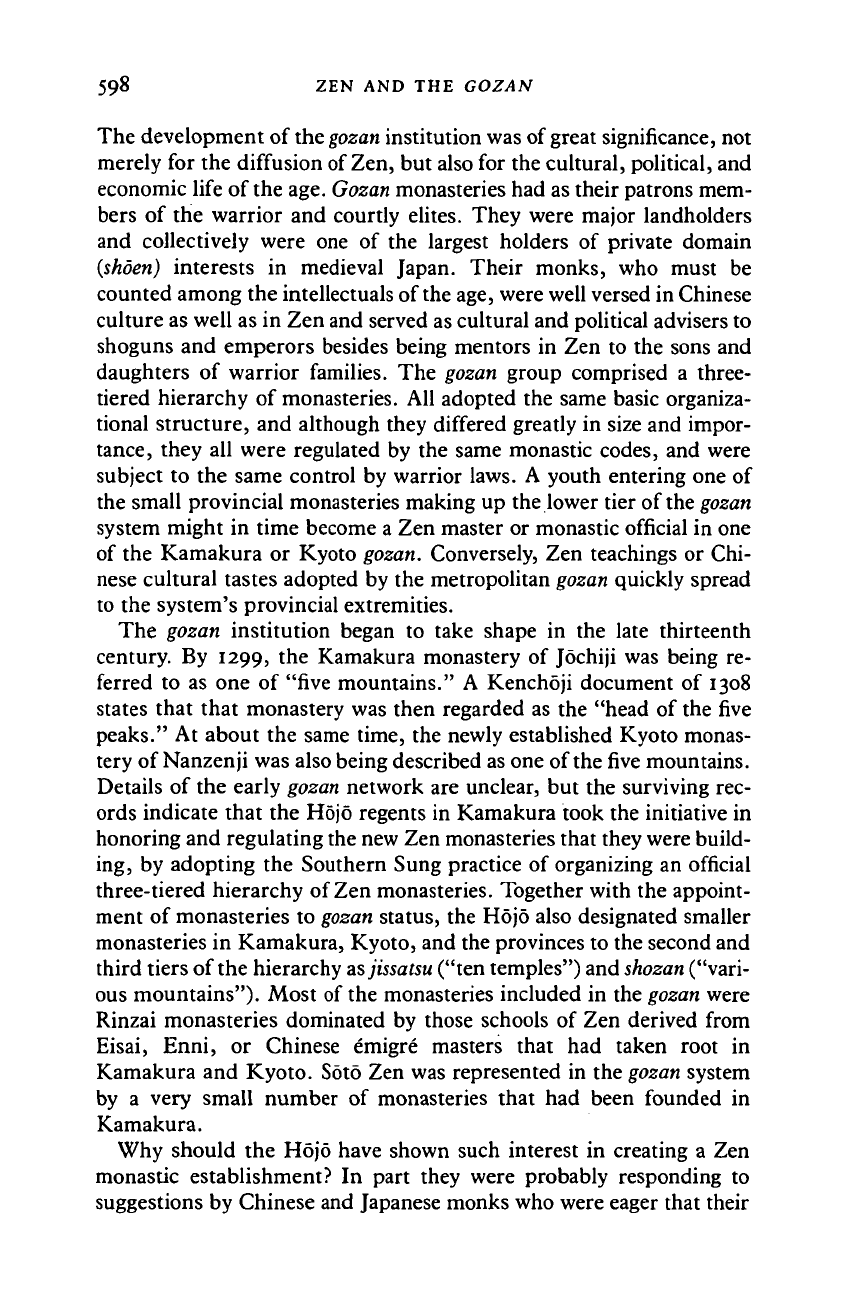
598 ZEN AND THE GOZAN
The development of the
gozan
institution was of great significance, not
merely for the diffusion of Zen, but also for the cultural, political, and
economic life of the age.
Gozan
monasteries had as their patrons mem-
bers of the warrior and courtly elites. They were major landholders
and collectively were one of the largest holders of private domain
(shoen) interests in medieval Japan. Their monks, who must be
counted among the intellectuals of the age, were well versed in Chinese
culture as well as in Zen and served as cultural and political advisers to
shoguns and emperors besides being mentors in Zen to the sons and
daughters of warrior families. The gozan group comprised a three-
tiered hierarchy of monasteries. All adopted the same basic organiza-
tional structure, and although they differed greatly in size and impor-
tance, they all were regulated by the same monastic codes, and were
subject to the same control by warrior laws. A youth entering one of
the small provincial monasteries making up the lower tier of the
gozan
system might in time become a Zen master or monastic official in one
of the Kamakura or Kyoto
gozan.
Conversely, Zen teachings or Chi-
nese cultural tastes adopted by the metropolitan
gozan
quickly spread
to the system's provincial extremities.
The gozan institution began to take shape in the late thirteenth
century. By 1299, the Kamakura monastery of Jochiji was being re-
ferred to as one of "five mountains." A Kenchoji document of 1308
states that that monastery was then regarded as the "head of the five
peaks."
At about the same time, the newly established Kyoto monas-
tery of Nanzenji was also being described as one of
the
five
mountains.
Details of the early
gozan
network are unclear, but the surviving rec-
ords indicate that the Hojo regents in Kamakura took the initiative in
honoring and regulating the new Zen monasteries that they were build-
ing, by adopting the Southern Sung practice of organizing an official
three-tiered hierarchy of Zen monasteries. Together with the appoint-
ment of monasteries to
gozan
status, the Hojo also designated smaller
monasteries in Kamakura, Kyoto, and the provinces to the second and
third tiers of the hierarchy as
jissatsu
("ten temples") and
shozan
("vari-
ous mountains"). Most of the monasteries included in the
gozan
were
Rinzai monasteries dominated by those schools of Zen derived from
Eisai, Enni, or Chinese emigre masters that had taken root in
Kamakura and Kyoto. Sot 6 Zen was represented in the
gozan
system
by a very small number of monasteries that had been founded in
Kamakura.
Why should the Hojo have shown such interest in creating a Zen
monastic establishment? In part they were probably responding to
suggestions by Chinese and Japanese monks who were eager that their
Cambridge Histories Online © Cambridge University Press, 2008
